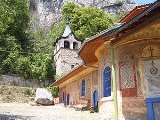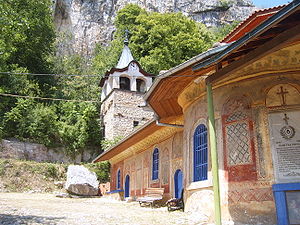
Transfiguration Monastery
Encyclopedia

Transfiguration of Jesus
The Transfiguration of Jesus is an event reported in the New Testament in which Jesus is transfigured and becomes radiant upon a mountain. The Synoptic Gospels describe it, and 2 Peter 1:16-18 refers to it....
(манастир "Свето Преображение Господне", manastir "Sveto Preobrazhenie Gospodne") is an Eastern Orthodox
Eastern Orthodox Church
The Orthodox Church, officially called the Orthodox Catholic Church and commonly referred to as the Eastern Orthodox Church, is the second largest Christian denomination in the world, with an estimated 300 million adherents mainly in the countries of Belarus, Bulgaria, Cyprus, Georgia, Greece,...
monastery located in the Dervent gorge of the Yantra River
Yantra River
The Yantra is a river in northern Bulgaria, a right tributary of the Danube. It is 285 km long and has a watershed of 7,862 km²....
. It lies near the village of Samovodene, seven kilometres north of Veliko Tarnovo
Veliko Tarnovo
Veliko Tarnovo is a city in north central Bulgaria and the administrative centre of Veliko Tarnovo Province. Often referred to as the "City of the Tsars", Veliko Tarnovo is located on the Yantra River and is famous as the historical capital of the Second Bulgarian Empire, attracting many tourists...
, in central northern Bulgaria
Bulgaria
Bulgaria , officially the Republic of Bulgaria , is a parliamentary democracy within a unitary constitutional republic in Southeast Europe. The country borders Romania to the north, Serbia and Macedonia to the west, Greece and Turkey to the south, as well as the Black Sea to the east...
. It is one of the five stauropegic
Stauropegic
Stauropegic, also rendered stavropegic, stauropegial, or stavropegial is a title or description applied to Eastern Orthodox and Eastern Catholic Christian monasteries subordinated directly to a Patriarch or Synod, rather than to their local Bishop...
monasteries of the Bulgarian Orthodox Church
Bulgarian Orthodox Church
The Bulgarian Orthodox Church - Bulgarian Patriarchate is an autocephalous Eastern Orthodox Church with some 6.5 million members in the Republic of Bulgaria and between 1.5 and 2.0 million members in a number of European countries, the Americas and Australia...
.
It is thought that the monastery was founded in the 11th century AD as a cloister of the Vatopedi monastery on Mount Athos
Mount Athos
Mount Athos is a mountain and peninsula in Macedonia, Greece. A World Heritage Site, it is home to 20 Eastern Orthodox monasteries and forms a self-governed monastic state within the sovereignty of the Hellenic Republic. Spiritually, Mount Athos comes under the direct jurisdiction of the...
. In 1360, when Tarnovo was the capital of the Second Bulgarian Empire
Second Bulgarian Empire
The Second Bulgarian Empire was a medieval Bulgarian state which existed between 1185 and 1396 . A successor of the First Bulgarian Empire, it reached the peak of its power under Kaloyan and Ivan Asen II before gradually being conquered by the Ottomans in the late 14th-early 15th century...
and the traditions of hesychasm
Hesychasm
Hesychasm is an eremitic tradition of prayer in the Eastern Orthodox Church, and some of the Eastern Catholic Churches, such as the Byzantine Rite, practised by the Hesychast Hesychasm is an eremitic tradition of prayer in the Eastern Orthodox Church, and some of the Eastern Catholic Churches,...
were popular in Bulgaria, it became an autonomous monastery on the order of Tsar Ivan Alexander of Bulgaria
Ivan Alexander of Bulgaria
Ivan Alexander , also known as John Alexander, ruled as Emperor of Bulgaria from 1331 to 1371, during the Second Bulgarian Empire. The date of his birth is unknown. He died on February 17, 1371. The long reign of Ivan Alexander is considered a transitional period in Bulgarian medieval history...
. This is legendarily tied to the charity of Ivan Alexander's second wife Sarah-Theodora and their son Ivan Shishman
Ivan Shishman of Bulgaria
Ivan Shishman ruled as emperor of Bulgaria in Tarnovo from 1371 to 3 July 1395. The authority of Ivan Shishman was limited to the central parts of the Bulgarian Empire. His indecisive and inconsistent policy did little to prevent the fall of his country under Ottoman rule. In 1393 the Ottoman...
, a reason to also call the monastery Sarah's or Shishman's monastery.
After the Ottoman
Ottoman Empire
The Ottoman EmpireIt was usually referred to as the "Ottoman Empire", the "Turkish Empire", the "Ottoman Caliphate" or more commonly "Turkey" by its contemporaries...
conquest of Bulgaria, the monastery was plundered and burned several times by the Turks and eventually entirely destroyed. It was only reestablished in 1825 by father Zoticus of the Rila Monastery
Rila Monastery
The Monastery of Saint Ivan of Rila, better known as the Rila Monastery is the largest and most famous Eastern Orthodox monastery in Bulgaria. It is situated in the southwestern Rila Mountains, south of the capital Sofia in the deep valley of the Rilska River at an elevation of above sea level...
by means of donations. In 1832, a firman
Firman
A firman is a royal mandate or decree issued by a sovereign in certain historical Islamic states, including the Ottoman Empire, Mughal Empire, State of Hyderabad, and Iran under Shah Mohammed Reza Pahlavi. The word firman comes from the meaning "decree" or "order"...
of the Ottoman sultan allowed the construction of a new monastery church; the church was designed by the noted Bulgarian National Revival
Bulgarian National Revival
The Bulgarian National Revival , sometimes called the Bulgarian Renaissance, was a period of socio-economic development and national integration among Bulgarian people under Ottoman rule...
architect Kolyu Ficheto
Kolyu Ficheto
Nikola Fichev , commonly known as Kolyu Ficheto , was a Bulgarian National Revival architect, builder and sculptor born in Dryanovo in 1800....
and completed in 1834. The cross-shaped church features three apse
Apse
In architecture, the apse is a semicircular recess covered with a hemispherical vault or semi-dome...
s, a single dome
Dome
A dome is a structural element of architecture that resembles the hollow upper half of a sphere. Dome structures made of various materials have a long architectural lineage extending into prehistory....
and a covered narthex
Narthex
The narthex of a church is the entrance or lobby area, located at the end of the nave, at the far end from the church's main altar. Traditionally the narthex was a part of the church building, but was not considered part of the church proper...
. The icons and frescoes of the main church were painted by another famous artist, Zahari Zograf
Zahari Zograf
Zahariy Hristovich Dimitrov , better known as Zahari Zograf is arguably the most famous Bulgarian painter of the Bulgarian National Revival, noted for his church mural paintings and icons and often regarded as the founder of secular art in Bulgaria due to the introduction of everyday life...
, who worked in the monastery between 1849 and 1851, after he finished his decoration of the Troyan Monastery
Troyan Monastery
The Monastery of the Dormition of the Most Holy Mother of God or, as it is more commonly called, the Troyan Monastery is the third largest monastery in Bulgaria...
. Among the more notable murals are those of the Last Judgment
Last Judgment
The Last Judgment, Final Judgment, Day of Judgment, Judgment Day, or The Day of the Lord in Christian theology, is the final and eternal judgment by God of every nation. The concept is found in all the Canonical gospels, particularly the Gospel of Matthew. It will purportedly take place after the...
, the Wheel of Life, the Birth of the Mother of God, the Last Supper
Last Supper
The Last Supper is the final meal that, according to Christian belief, Jesus shared with his Twelve Apostles in Jerusalem before his crucifixion. The Last Supper provides the scriptural basis for the Eucharist, also known as "communion" or "the Lord's Supper".The First Epistle to the Corinthians is...
. Zograf also painted Saints Cyril and Methodius, as well as a self-portrait. In addition, the main church was richly decorated on the outside and a wood-carved and gold-plated iconostasis
Iconostasis
In Eastern Christianity an iconostasis is a wall of icons and religious paintings, separating the nave from the sanctuary in a church. Iconostasis also refers to a portable icon stand that can be placed anywhere within a church...
was installed.
Between 1858 and 1863 Kolyu Ficheto constructed the seven-bell belfry
Bell tower
A bell tower is a tower which contains one or more bells, or which is designed to hold bells, even if it has none. In the European tradition, such a tower most commonly serves as part of a church and contains church bells. When attached to a city hall or other civic building, especially in...
, the residential buildings and the main entrance, as well as the underground chapel
Chapel
A chapel is a building used by Christians as a place of fellowship and worship. It may be part of a larger structure or complex, such as a church, college, hospital, palace, prison or funeral home, located on board a military or commercial ship, or it may be an entirely free-standing building,...
of Saint Andrew
Saint Andrew
Saint Andrew , called in the Orthodox tradition Prōtoklētos, or the First-called, is a Christian Apostle and the brother of Saint Peter. The name "Andrew" , like other Greek names, appears to have been common among the Jews from the 3rd or 2nd century BC. No Hebrew or Aramaic name is recorded for him...
the First-called and the small Church of the Annunciation
Annunciation
The Annunciation, also referred to as the Annunciation to the Blessed Virgin Mary or Annunciation of the Lord, is the Christian celebration of the announcement by the angel Gabriel to Virgin Mary, that she would conceive and become the mother of Jesus the Son of God. Gabriel told Mary to name her...
on top of it, with icons by Zahari Zograf's nephew Stanislav Dospevski
Stanislav Dospevski
Stanislav Dospevski is the name assumed by Zafir Zograf , the son of Dimitar Zograf and nephew of the famed Bulgarian icon and mural painter, Zahari Zograf. He is a notable representative of the Samokov artistic school and one of the most important painters and icon-painters of the Bulgarian...
.

